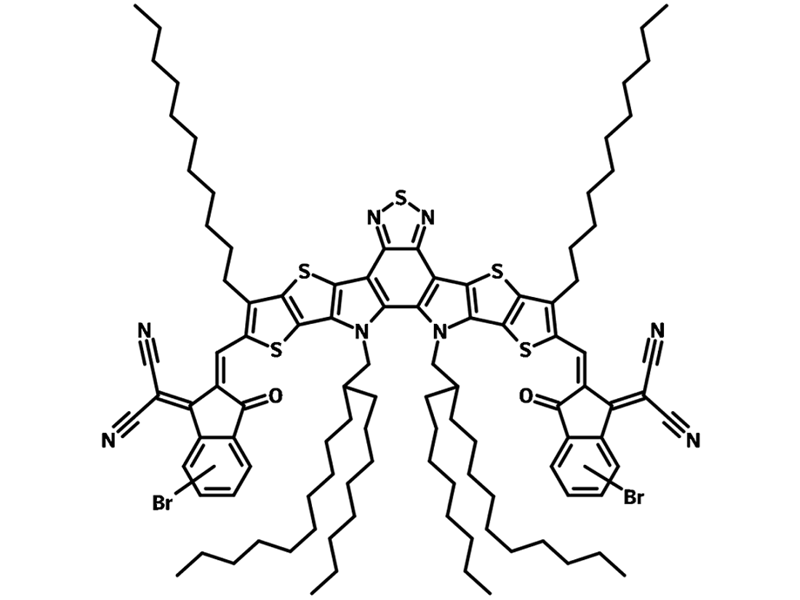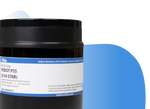TPT10-C8C12, TP10 derivative with improved solubility
High purity (≥98%) TPT10-C8C12 for low cost non-fullerene polymer solar cells
Specifications | Pricing and Options | MSDS | Literature and Reviews
TPT10-C8C12 is a family member of the popular non-fullerene acceptor, TPT10 (itself similar to Y6 and Y7). The only difference in chemical structure between TPT10-C8C12 and TPT10 is that the former has larger butyldodecyl side chains. As a result, TPT10-C8C12 is more soluble in common solvents.
Coupled with the wide bandgap copolymer PTQ11, TPT10 has made low-cost, high efficiency non-fullerene polymer solar cells a realistic possibility. The higher solubility of TPT10-C8C12 also makes it possible for non-fullerene polymer solar cells to be solution processible in non-halogenated solvents such as toluene or THF.
We supply high purity (≥98%) TPT10-C8C12 worldwide. Quantities from 100 mg to 1 g are available to buy online (please contact us for larger orders) and eligible orders ship free.
High efficient non-fullerene acceptor
With highly conjugated core
Enhanced solubility
with octyldodecyl alkyl chains
Worldwide shipping
Quick and reliable shipping
Green energy materials
Processable in non-halogenated solvents
General Information
| CAS Number | N/A |
| Chemical Formula | C106H136Br2N8O2S5 |
| Purity | ≥98% (1HNMR) |
| Full Name | 2,2'- [[12,13-Bis(2-octyldodecyl)-12,13-dihydro-3,9-dinonylbisthieno[2'',3'':4',5']thieno[2',3':4,5]pyrrolo[3,2-e:2',3'-g][2,1,3]benzothiadiazole-2,10-diyl]bis[methylidyne(5 or 6-bromo-3-oxo-1H-indene-2,1(3H)-diylidene) ]]bis[propanedinitrile] |
| Molecular Weight | 1874.45 g/mol |
| HOMO / LUMO | HOMO = -5.52 eV, LUMO = -3.99 eV (TPT10) |
| UV-Vis | 817 nm (in film) |
| Solubility | Toluene, chloroform, chlorobenzene |
| Form | Dark blue powder/crystal |
| Synonyms | BTP-2Br-C8C12, TPT10-OD |
| Classification / Family | BTP series NFAs, n-type non-fullerene electron acceptors, organic semiconducting materials, low band-gap small molecule, small molecular acceptor, organic photovoltaics, polymer solar cells, NF-PSCs |
Chemical Structure

MSDS Documentation
Pricing
| Batch | Quantity | Price |
| M2253A1 | 100 mg | £370 |
| M2253A1 | 250 mg | £740 |
| M2253A1 | 500 mg | £1250 |
| M2253A1 | 1 g | £2300 |
| M2253A1 | 5 g / 10 g | Please contact us for details |
For orders of 5 g or more, a lead time of 4 - 6 weeks applies
Literature and Reviews
- High Efficiency Polymer Solar Cells with Efficient Hole Transfer at Zero Highest Occupied Molecular Orbital Offset between Methylated Polymer Donor and Brominated Acceptor, C. Sun et al., J. Am. Chem. Soc., 142, 1465−1474 (2020); DOI: 10.1021/jacs.9b09939.
- Bromination: An Alternative Strategy for Non‐Fullerene Small Molecule Acceptors, H. Wang et al., Adv. Sci (Weinh), 7(9), 1903784 (2020); DOI: 10.1002/advs.201903784.
Related Products
Semiconducting polymers for bulk heterojunction, OPV, OLED, OFET and perovskite interfaces and solar cell research.


